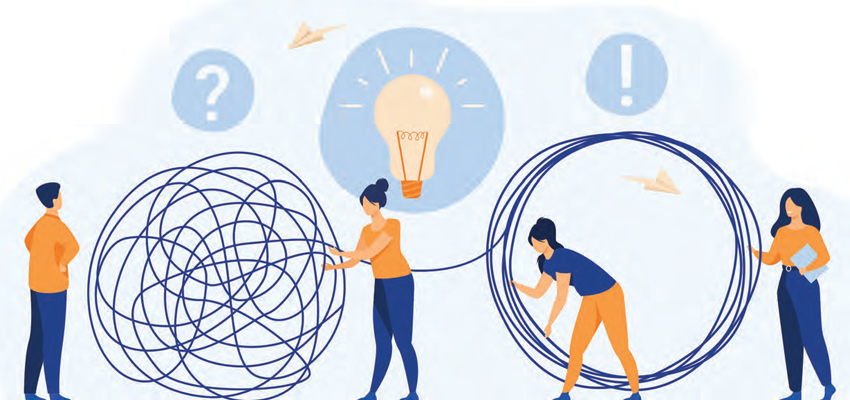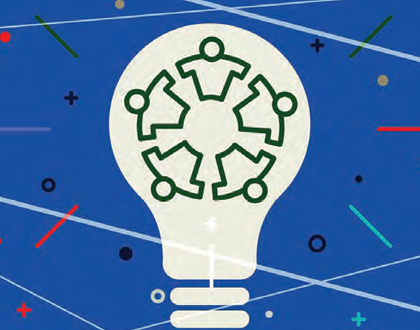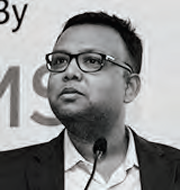Driving Strategic Agility

Strategy is the keyword when you want to deliver results and capture the market seamlessly. But there is much more to strategy than it appears. Being agile means being flexible, resilient and learning from mistakes. Strategic agility working comes in terms with agile teams, agile units and agility of the firm. Organisations need to implement the mindset of strategic agility in order to be strategically agile.
At a recently conducted seminar, Vinay Shrivastava, Business Head - FMCG, Udaan, talked about what is the meaning of strategic agility, how it is essential in this VUCA world and why it gives results as compared to traditional hierarchy led organisations.
Vinay is skilled at setting and scaling up new business and entrepreneurial ventures, cross-industry expertise in General Management and Sales & Marketing; extensive experience in Digital Marketing & Advocacy, Brand Management, Innovation, Omni Channel Expert (Ecom, General Trade - across the spectrum from Kirana to Wholesale and Self Service outlets; Modern Trade – National and Regional Chains)
"In case of a strategically agile organisation, it is a real product demonstration. You like the product or you don’t like the product. You don’t need to make it pass through various things. Real-time feedback and validation keep things moving"
 Vinay Shrivastava
Vinay ShrivastavaThe ability to respond in real-time to market changes and macroeconomic conditions is called strategic agility. While the definition may seem heavy, very simply put, it is about entering into new markets with new products and addressing a new set of consumers. It is not about driving efficiencies in the same market or with the same products. The real question is can you address a completely new set of markets and products to a completely new set of consumers?
Operational vs. Strategic agility
Let us first understand the difference between operational agility and strategic agility. If you look at the three steps, where you have agile teams, agile units and which lead to agile firms,this is where operational agility ends. What you gain from operational agility is, more efficiency and quality improvements. Nevertheless, if you are trying to do completely different and innovative solutions, which you are trying to build into the market, to a completely new set of consumers, you have to have strategic agility. The fundamental difference is a change in the mindset-more than anything else.
How strategically agile organisations are different? There are traditional organisations, which largely have a top-down bureaucracy or hierarchy, and if you have a bureaucracy, it further enables agility. In these organisations, if you look at people who work in silos, they have their key-result areas, which are largely limited to a function. There is nothing called as a universal entity that binds everything. There is no cohesion between teams so everybody is striving to improvise his or her function rather than meeting an overall objective.
If you look at strategically agile organisations, every member is like an organism there. There are no fixed boxes as such; everybody focuses on action. How do you get things done? If someone says, I will lead the Research & Development department or I will lead the Marketing Department, the lines are blurred. For example, if I am a marketer, can I help the R&D departmentas well? At the end of the day, it is the outcome, which matters, and not merely the input.
Secondly, it is all about quick changes. Can roles be changed quickly? As and when there is a need, can people move in and help the person out? It is about flexible resources. Thirdly, the most crucial aspect is end-to-end accountability and not functional accountability. It is outcome-focussed vs. saying I am responsible for a function. Leaders, here, are enabling more directions and they label action rather than just saying this is what needs to be done and this is what is required to be done. How can you enable it? The role of a leader changes completely.

Agile organisations vs. strategically agile organisations
As I said earlier, it is about a change in the mindset, so between a traditional and agile organisation, I will cite a few steps that every organisation follows and how it is different from traditional and strategically agile organisations. In case of how do you evaluate progress in a traditional organisation, for example, on any project, you will do documentation, you will do signoffs, you will pass stage gates, that is a very step-by step-process. But in the case of a strategically agile organisation, it is a real product demonstration. You like the product or you don’t like the product. You don’t need to make it pass through various things. Real-time feedback and validation keep things moving.
In terms of scheduling and planning, I believe this is the time, where everyone makes a plan for the year. That is largely the case with traditional organisations, in the case of agile rganisations, in case you make a plan, you try to keep improvising it. Every quarter you can improvise the plan so that the targets can also shift. Don’t create the market for the present, create a market for the future. You don’t know how well the future would come closer, therefore, the size of the market would grow phenomenally, and therefore, what you had planned for the begin-ning of the year, could not just hold true.
In terms of management and team structure, largely, traditional organisations are hierarchy-led but in the case of management team structure for a strategically agile organisation, I believe servant leadership is something, which is very important for the leader to imbibe, and it is something close to my heart as well. I believe that the three fundamental tenets or attributes of a student leader is humility, empathy and a great listening skill. These attributes are something, which a servant leader has. That is where you try to absorb all the information around you, make sense of the information and that’s how you come up with the best thing. Therefore, listening is extremely critical.
If we consider the guiding principles in large organisations or hierarchy-led organisations, there is a thought that can you get it right the first time. I believe that only a team can help you understand what they can get but everything changes when you get into the market. Let’s say, if a team of 10 people have evaluated a product, there are hundreds and thousands of people who will try the product and will have views and feedbacks on the products. Can you continuously improve and learn by doing it? That becomes even more critical and that is where strategically agile organisations achieve a point over traditional organisations.
"The consumer is evolving, you will have to keep up with the consumer and move one-step ahead, give him the solutions to what he is looking at rather than giving him products. That is what is required for a strategically agile organisation"
- Vinay Shrivastava

Why it is important to be strategically agile?
Organisations are not able to keep pace with the innovations and innovation is something, which is a must for survival. You need to continuously evolve and upgrade yourself, that’s how it works. If you look at why a human lifespan is increasing every year, I believe that it is due to innovations in the medical field, innovations in the food technology, and innovations across the world, innovations across various aspects which keep on improvising the human lives and that is why the lifespan is increasing. The same thing has to be done at an organisational level and that is how organisations will extend their lifespan.
If I look at strategically agile organisations and how they affect business, some of the key metrics are: fitness to market increases by 75%, the quality of the product(s) improve by 50%, productivity increases by around 20%-50% and engagement increases by around 10%. This data was provided by a survey done by a company called Scaled Agile, it is a US organisation.
Another reason why organisations need to be strategically agile is that I believe sectorial boundaries are collapsing. People who could be your partners today-tomorrow, they could be your competitors. As a result, you have to innovate continuously. Secondly, a consumer has become more aware, collected and empowered. Therefore, the customer is looking for things that are more new. As a result, the need for innovation, being strategically agile, becomes even more important.
I will state some examples. Apple Inc. is a brilliant example, it started with desktop computers, it then moved into mobile computing with iPads, iPhones etc. Further, Apple moved multiple devices into one system-the Apple ecosystem. If you want to get out of the Apple ecosystem, I personally find it very difficult. I use a Macbook Air and an iPad among others. Finally, they started giving on-demand music services. It started from a static desktop computer to mobile computing to on-demand music. You completely keep on shifting trajectories because it is about consumer centricity; it is about what is the consumer is looking at.
Another interesting example is that of Amazon. Amazon started with an online marketplace. It built its own brand and categories where it felt that a need is there, and today, we have an AI assistant. From a marketplace to an AI assistant, I believe the journey has been phenomenal.
Another example is of Netflix. Netflix started as a DVD rental company and then moved to web-based streaming. Now, they are content producers. It is only when you think about how your consumer is evolving and where he is moving to will you keep on shifting the paradigm, otherwise, what will happen is you will continue to be a DVD rental company and life would end there.
"The speed of execution is very critical, the other important learning is to fail and learn quickly. Do multiple iterations. Failures are a part of life and it is important to accept what is failed and work on it"

Evolve with consumers
The consumer is evolving, you will have to keep up with the consumer and move one step ahead, give him the solutions to what he is looking at rather than giving him products. That is what is required for a strategically agile organisation.
If I look at the four levers that are to be pressed to be strategically agile. The first is strategic vision; the second is resource flexibility, the third is swift execution, and the last is de-cluttering management hierarchies.
Strategic vision: It is nothing but keeping consumers first or it should be all about consumer centricity. You are creating a solution for a consumer, he has to be of prime importance, and everything will follow through. It is identifying the core consumer needs and then getting into a category or a product. It should always be consumer first and not category first. For example, we recently launched a product called Saffola Fittify. The idea of the launch was to provide the consumers who are looking at a slimmer and fitter life. That is what the need was, and we came up with various product formats, we did not limit ourselves to one format only. For example, we didn’t want to get into green teas or coffees. We thought, can we provide a solution to a fitter life of the consumer and there could be multiple ways of doing so. That is how we came with multiple categories.
Think deep and wide: I think the consumer today is open to a wide level of thoughts, ideas and is ready to experiment. Therefore, there are umpteen number of opportunities. Can you take advantage of it? Can you provide solutions? One very important thing, which I would like to highlight here is the market decides what it requires rather than what you decide. It is again the difference between launching something, which you feel is perfect vs. iterate and take it to the path of perfection. If you look at Saffola, we launched 20 products in six categories. I believe that for Marico, we have done for the first time. For instance, iterating to perfection vs. launching with perfection, if I take the example of green tea, you can come out with five flavours, do all the necessary benchmarks, test it with consumers, but when you take it to the market, there would be consumers who would be looking at the sixth or seventh flavour. In addition, there would be people who would not like the flavours the ones you have liked. Hence, it is good to start your journey with 3-4 flavours, test it in the market and then you can keep on iterating, increase or decrease the strength of the flavour of the five launched products; three may work and two may not work. You may try to keep coming up with new ones and that is how you achieve perfection. On the other hand, there is nothing as perfection, since the consumer keeps evolving with every passing day-there is some new information, which the consumer gets. The faster you evolve your brand, the faster you will meet the demands of your consumers.
The next most important part of strategically agile organisations is resource flexibility. While you do the manpower planning in the beginning of the year that is where a lot of changes keep happening during the course of the year as well. Though you hire people for skills, you also hire people for results; you make result-oriented teams rather than skill-oriented teams. Skill is a necessity while the result is a must. You make empowered cross-functional teams, which are open to experiment and to shift roles from one role to another. You need not be a master of anything, for example, there may an R&D head to guide his team, however, he would need resources. At the end of the day, results account for and are not functional expertise or function winning vs. the results not being done. Team members who can own the entire project and work as silos.
The other important part of resourcing is identifying the partners and not vendors. You should be ready to learn from partners and you should forge alliances rather than learn by yourself. If you can have a great partner who can bring synergy along, there is nothing like it. You should take him on board and work together so that you and the partner also gain. Align with equal partners and the stakes are linked with 29results. If you win, the partner wins. If you don’t win, the partner also doesn’t win. The chances to win are very high if the focus is on the result.
Executional prowess: This is where most of the organisations even if have done the first two parts, are usually are not able to do this. There is a saying by Eric Ries which I follow to the tee-“think big, start small and scale fast”. To think big you need to have a strategic vision in mind; start small: this is where you try multiple things, iterate a few things and then scale. The minute you find the levers, which you find to be working, just scale it, don’t wait. The speed of execution is very critical, the other important learning is to fail and learn quickly. Do multiple iterations. Failures are a part of life and it is important to accept what is failed and work on it.